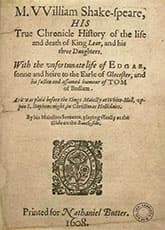King Lear
Critique • Other critiques • Quotes • Text
 Title page 1619 quarto
Title page 1619 quartoAlso known as
The Tragedy of King Lear
Written
c. 1603–1606
First performance
c. 1606
First publication
1608
Literature form
Play
Genres
Tragedy
Writing language
English
Author's country
England
Length
Five acts, 3,487 lines, approx. 25,000 words
Teetering on the abyss
A straightforward play really, about a dysfunctional family. People thinks it's cosmic because of that annoying storm in the middle.
That's not my opinion but the summary of Jonathan Miller, given in a television interview while he was directing King Lear at Stratford, Ontario in 2002.
Yet Lear is considered along with Hamlet one of the great peaks of tragic drama to be scaled. Like other Shakespearean plays, it has become so encrusted with centuries of respect, so widely and allegorically applied in our culture, that it does seem to take on cosmic significance to us. Still, it's helpful to be reminded that King Lear is basically a tale about the corrupted relations of a man and his daughters.
The deep significance the tale takes on for us is in the play itself, not just something we've arbitrarily decided to add. Lear, the character, is jerked out of complacent old age into facing the big questions as a result of his distorted familial relations. In a way the play may be taken to show how closely to the abyss we ride in normal life. Whether we fall over the edge as Lear does or whether we stay perched high and dry depends to a large degree on how we play the social game, how well we respect the social relationships closest to us.
Of course, that's my usual socio-political take on it. The popular line is that Lear's tragic downfall is a result of his own foolishness.
As we know it
The plot is well known. Lear is a monarch of old Britain, a self-centred old man, who decides to divide his kingdom among his three daughters according to their expressed affection for him. Goneril, who is married to the duke of Albany, and Regan, married to the duke of Cornwall, hypocritically profess extravagant love for him. The unmarried Cordelia is honest is saying she loves him according to her duty. Lear angrily gives her portion of the kingdom to her sisters. The two sisters, after taking over, turn against their father, eventually tossing him out of their gates into a storm.
Lear howls against the fates, banters with his fool and loses his mind. The Earl of Gloucester who stands up for the old king has his eyes put out. Lear is taken by another faithful lord to Dover, where Cordelia who has married the king of France receives him. Goneril and Regan become rivals and both die in a murder-suicide. The French invade England but are defeated.
The conclusion we know today has Lear imprisoned and Cordelia hanged. Lear dies from guilt-ridden grief, his dead daughter's body in his arms, in the last pitiful scene.
It's interesting that for many years, the King Lear that people saw on stage had a far different ending. Shakespeare's play was revised in the mid-1600s so that Cordelia and Gloucester's son Edgar were romantically linked and victorious in battle, allowing both their fathers, Lear and Gloucester, to retire in peace. The sharp-tongued fool was eliminated altogether. Shakespeare's more tragic text remained unappreciated and overshadowed by this lighter version until the original was finally restored to popularity more than two centuries after his death.
Another attempt to edge us away from peering into the abyss, foiled by history.
— Eric
Critique • Other critiques • Quotes • Text

